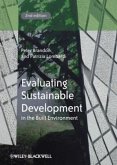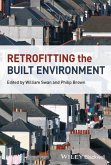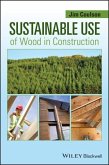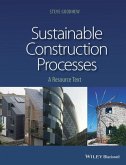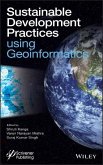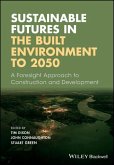- Gebundenes Buch
- Merkliste
- Auf die Merkliste
- Bewerten Bewerten
- Teilen
- Produkt teilen
- Produkterinnerung
- Produkterinnerung
This book provides an inventory of organic materials and products, the major components of all civil engineering projects, in terms of their scientific and technical background, including the regulations that cover their use and their predicted useful life. Such materials include: bitumen on the roads; geotextiles for retaining walls; membranes for bridges; tunnel and reservoir waterproofing; paint binders to protect metallic and concrete structures or to realize road markings; injection resins; gluing products; concrete admixtures; and composite materials.
The presentation is based on a…mehr
Andere Kunden interessierten sich auch für
![Evaluating Sustainable Development in the Built Environment Evaluating Sustainable Development in the Built Environment]() Peter BrandonEvaluating Sustainable Development in the Built Environment116,99 €
Peter BrandonEvaluating Sustainable Development in the Built Environment116,99 €![Retrofitting the Built Environment Retrofitting the Built Environment]() Retrofitting the Built Environment141,99 €
Retrofitting the Built Environment141,99 €![Sustainable Use of Wood in Construction Sustainable Use of Wood in Construction]() Jim CoulsonSustainable Use of Wood in Construction86,99 €
Jim CoulsonSustainable Use of Wood in Construction86,99 €![Green Roof Retrofit Green Roof Retrofit]() Sara J. WilkinsonGreen Roof Retrofit142,99 €
Sara J. WilkinsonGreen Roof Retrofit142,99 €![Sustainable Construction Processes Sustainable Construction Processes]() Steve GoodhewSustainable Construction Processes99,99 €
Steve GoodhewSustainable Construction Processes99,99 €![Sustainable Development Practices Using Geoinformatics Sustainable Development Practices Using Geoinformatics]() Sustainable Development Practices Using Geoinformatics256,99 €
Sustainable Development Practices Using Geoinformatics256,99 €![Sustainable Futures in the Built Environment to 2050 Sustainable Futures in the Built Environment to 2050]() Sustainable Futures in the Built Environment to 2050159,99 €
Sustainable Futures in the Built Environment to 2050159,99 €-
-
-
This book provides an inventory of organic materials and products, the major components of all civil engineering projects, in terms of their scientific and technical background, including the regulations that cover their use and their predicted useful life. Such materials include: bitumen on the roads; geotextiles for retaining walls; membranes for bridges; tunnel and reservoir waterproofing; paint binders to protect metallic and concrete structures or to realize road markings; injection resins; gluing products; concrete admixtures; and composite materials.
The presentation is based on a physicochemical approach, which is essential if these products are to be considered as part of sustainable development: as such, those studying or working in these fields will find this an invaluable source of information.
Hinweis: Dieser Artikel kann nur an eine deutsche Lieferadresse ausgeliefert werden.
The presentation is based on a physicochemical approach, which is essential if these products are to be considered as part of sustainable development: as such, those studying or working in these fields will find this an invaluable source of information.
Hinweis: Dieser Artikel kann nur an eine deutsche Lieferadresse ausgeliefert werden.
Produktdetails
- Produktdetails
- Verlag: Wiley & Sons
- 1. Auflage
- Seitenzahl: 651
- Erscheinungstermin: 11. April 2011
- Englisch
- Abmessung: 231mm x 160mm x 43mm
- Gewicht: 1130g
- ISBN-13: 9781848212244
- ISBN-10: 1848212240
- Artikelnr.: 32448428
- Herstellerkennzeichnung
- Libri GmbH
- Europaallee 1
- 36244 Bad Hersfeld
- gpsr@libri.de
- Verlag: Wiley & Sons
- 1. Auflage
- Seitenzahl: 651
- Erscheinungstermin: 11. April 2011
- Englisch
- Abmessung: 231mm x 160mm x 43mm
- Gewicht: 1130g
- ISBN-13: 9781848212244
- ISBN-10: 1848212240
- Artikelnr.: 32448428
- Herstellerkennzeichnung
- Libri GmbH
- Europaallee 1
- 36244 Bad Hersfeld
- gpsr@libri.de
Yves Mouton is a chemical engineer and a specialist in civil engineering. He has been active for nearly 40 years at the LCPC (Central Laboratory for Structures and Roads) in Paris and is Professor of Materials Science at the ENTPE (State national school of public works).
Introduction xxiii
Yves MOUTON
PART 1. PROBLEMS REGARDING ORGANIC MATERIALS AND SUSTAINABLE DEVELOPMENT 1
Chapter 1. Organic materials used in Construction at the Dawn of the Third
Millennium 3
Michel DE LONGCAMP and Yves MOUTON
Chapter 2. Sustainable Development Issues Regarding Organic Materials used
in Civil Engineering 15
Agnès JULLIEN
Chapter 3. Health Risks of Organic Materials used in Construction: What is
the Situation Today? 37
Guy AUBURTIN
Chapter 4. Ecological Impacts of Organic Construction Materials: What is
the Situation Today? 51
Yves PERRODIN
PART 2. ORGANIC POLYMERS AS BUILDING MATERIALS 63
Chapter 5. Organic Polymers 65
Jacques VERDU and Bruno FAYOLLE
Chapter 6. Formulation of Plastics 121
Michel de LONGCAMP
Chapter 7. Ageing and Durability of Organic Polymers 131
Jacques VERDU and Bruno FAYOLLE
Chapter 8. Fireproofing polymeric materials: problems and solutions 179
Serge BOURBIGOT
Chapter 9. Organic Materials, Waste and Recycling 189
Vincent VERNEY
PART 3. MANUFACTURED PRODUCTS 203
Chapter 10. Geosynthetics and Waterproofing 205
Philippe MESTAT
Chapter 11. Waterproofing Buildings: The Point of View of an Expert 269
Gérard HÉMOND
Chapter 12. Elastomers and Rubbers used in Civil Engineering 283
Michel FRAGNET
PART 4. COMPOSITE MATERIALS, TENSILE STRUCTURES, TEXTILE ARCHITECTURE AND
TIMBER 313
Chapter 13. Composite Materials and Construction 315
Jean-François CARON
Chapter 14. Textile Materials: Architectural Applications 339
Bernard MAURIN and Romain FERRARI
Chapter 15. Wood 353
Rémy MOUTERDE
PART 5. ORGANIC BINDER-BASED MATERIALS 389
Chapter 16. Bitumen, Road Construction and Sustainable Development 391
Bernard LOMBARDI
Chapter 17. Industrial Mortars and Repairing Concrete Products 407
Pierre BOULANGER and Paulo GONCALO
Chapter 18. Waterborne Paints to Limit VOC Emissions: Interests and Limits
419
Emmanuel ARAGON and André MARGAILLAN
PART 6. ORGANIC COMPOUNDS BUILT-IN INTO CEMENT MATRICES 431
Chapter 19. Rheological Admixtures 433
Nicolas ROUSSEL
Chapter 20. Contributions of Organic Admixtures in Construction Processes
447
François CUSSIGH
Chapter 21. Organic Fibers in Cementitious Materials 457
Laetitia D'ALOIA-SCHWARTZENTRUBER
PART 7. PROBLEMS SPECIFIC TO ORGANIC MATERIALS: ADHESIVE BONDING AND
CHARACTERIZATION METHODS 483
Chapter 22. Adhesive Bonding, a Method for Construction 485
Thierry CHAUSSADENT
Chapter 23. Strengthening Concrete Structures by Externally Bonded
Composite Materials 503
Marc QUIERTANT
Chapter 24. Durability of FRP Strengthened Concrete Specimens under
Accelerated Ageing 529
Karim BENZARTI, Marc QUIERTANT, Sylvain CHATAIGNER and Christophe AUBAGNAC
Chapter 25. Characterization of Organic Materials used in Civil Engineering
by Chemical and Physico-chemical Methods 553
Fabienne FARCAS
PART 8. ORGANIC MATERIALS, CONSTRUCTION, ARCHITECTURE, CREATION AND
SUSTAINABLE DEVELOPMENT 583
Chapter 26. Organic Materials and Sustainable Architectural Design 585
Michel PAULIN
Chapter 27. Specific Contributions of Viscous Behavior Materials in
Construction 599
Bernard HALPHEN
Chapter 28. Organics in Construction - How Far? 609
Henri VAN DAMME
Chapter 29. Thoughts on the Futurology in Research and Development of
Innovative Materials 617
Jean BILLARD
Conclusion 631
François BUYLE-BODIN
Acronyms and Initials 639
List of Authors 645
Index 649
Yves MOUTON
PART 1. PROBLEMS REGARDING ORGANIC MATERIALS AND SUSTAINABLE DEVELOPMENT 1
Chapter 1. Organic materials used in Construction at the Dawn of the Third
Millennium 3
Michel DE LONGCAMP and Yves MOUTON
Chapter 2. Sustainable Development Issues Regarding Organic Materials used
in Civil Engineering 15
Agnès JULLIEN
Chapter 3. Health Risks of Organic Materials used in Construction: What is
the Situation Today? 37
Guy AUBURTIN
Chapter 4. Ecological Impacts of Organic Construction Materials: What is
the Situation Today? 51
Yves PERRODIN
PART 2. ORGANIC POLYMERS AS BUILDING MATERIALS 63
Chapter 5. Organic Polymers 65
Jacques VERDU and Bruno FAYOLLE
Chapter 6. Formulation of Plastics 121
Michel de LONGCAMP
Chapter 7. Ageing and Durability of Organic Polymers 131
Jacques VERDU and Bruno FAYOLLE
Chapter 8. Fireproofing polymeric materials: problems and solutions 179
Serge BOURBIGOT
Chapter 9. Organic Materials, Waste and Recycling 189
Vincent VERNEY
PART 3. MANUFACTURED PRODUCTS 203
Chapter 10. Geosynthetics and Waterproofing 205
Philippe MESTAT
Chapter 11. Waterproofing Buildings: The Point of View of an Expert 269
Gérard HÉMOND
Chapter 12. Elastomers and Rubbers used in Civil Engineering 283
Michel FRAGNET
PART 4. COMPOSITE MATERIALS, TENSILE STRUCTURES, TEXTILE ARCHITECTURE AND
TIMBER 313
Chapter 13. Composite Materials and Construction 315
Jean-François CARON
Chapter 14. Textile Materials: Architectural Applications 339
Bernard MAURIN and Romain FERRARI
Chapter 15. Wood 353
Rémy MOUTERDE
PART 5. ORGANIC BINDER-BASED MATERIALS 389
Chapter 16. Bitumen, Road Construction and Sustainable Development 391
Bernard LOMBARDI
Chapter 17. Industrial Mortars and Repairing Concrete Products 407
Pierre BOULANGER and Paulo GONCALO
Chapter 18. Waterborne Paints to Limit VOC Emissions: Interests and Limits
419
Emmanuel ARAGON and André MARGAILLAN
PART 6. ORGANIC COMPOUNDS BUILT-IN INTO CEMENT MATRICES 431
Chapter 19. Rheological Admixtures 433
Nicolas ROUSSEL
Chapter 20. Contributions of Organic Admixtures in Construction Processes
447
François CUSSIGH
Chapter 21. Organic Fibers in Cementitious Materials 457
Laetitia D'ALOIA-SCHWARTZENTRUBER
PART 7. PROBLEMS SPECIFIC TO ORGANIC MATERIALS: ADHESIVE BONDING AND
CHARACTERIZATION METHODS 483
Chapter 22. Adhesive Bonding, a Method for Construction 485
Thierry CHAUSSADENT
Chapter 23. Strengthening Concrete Structures by Externally Bonded
Composite Materials 503
Marc QUIERTANT
Chapter 24. Durability of FRP Strengthened Concrete Specimens under
Accelerated Ageing 529
Karim BENZARTI, Marc QUIERTANT, Sylvain CHATAIGNER and Christophe AUBAGNAC
Chapter 25. Characterization of Organic Materials used in Civil Engineering
by Chemical and Physico-chemical Methods 553
Fabienne FARCAS
PART 8. ORGANIC MATERIALS, CONSTRUCTION, ARCHITECTURE, CREATION AND
SUSTAINABLE DEVELOPMENT 583
Chapter 26. Organic Materials and Sustainable Architectural Design 585
Michel PAULIN
Chapter 27. Specific Contributions of Viscous Behavior Materials in
Construction 599
Bernard HALPHEN
Chapter 28. Organics in Construction - How Far? 609
Henri VAN DAMME
Chapter 29. Thoughts on the Futurology in Research and Development of
Innovative Materials 617
Jean BILLARD
Conclusion 631
François BUYLE-BODIN
Acronyms and Initials 639
List of Authors 645
Index 649
Introduction xxiii
Yves MOUTON
PART 1. PROBLEMS REGARDING ORGANIC MATERIALS AND SUSTAINABLE DEVELOPMENT 1
Chapter 1. Organic materials used in Construction at the Dawn of the Third
Millennium 3
Michel DE LONGCAMP and Yves MOUTON
Chapter 2. Sustainable Development Issues Regarding Organic Materials used
in Civil Engineering 15
Agnès JULLIEN
Chapter 3. Health Risks of Organic Materials used in Construction: What is
the Situation Today? 37
Guy AUBURTIN
Chapter 4. Ecological Impacts of Organic Construction Materials: What is
the Situation Today? 51
Yves PERRODIN
PART 2. ORGANIC POLYMERS AS BUILDING MATERIALS 63
Chapter 5. Organic Polymers 65
Jacques VERDU and Bruno FAYOLLE
Chapter 6. Formulation of Plastics 121
Michel de LONGCAMP
Chapter 7. Ageing and Durability of Organic Polymers 131
Jacques VERDU and Bruno FAYOLLE
Chapter 8. Fireproofing polymeric materials: problems and solutions 179
Serge BOURBIGOT
Chapter 9. Organic Materials, Waste and Recycling 189
Vincent VERNEY
PART 3. MANUFACTURED PRODUCTS 203
Chapter 10. Geosynthetics and Waterproofing 205
Philippe MESTAT
Chapter 11. Waterproofing Buildings: The Point of View of an Expert 269
Gérard HÉMOND
Chapter 12. Elastomers and Rubbers used in Civil Engineering 283
Michel FRAGNET
PART 4. COMPOSITE MATERIALS, TENSILE STRUCTURES, TEXTILE ARCHITECTURE AND
TIMBER 313
Chapter 13. Composite Materials and Construction 315
Jean-François CARON
Chapter 14. Textile Materials: Architectural Applications 339
Bernard MAURIN and Romain FERRARI
Chapter 15. Wood 353
Rémy MOUTERDE
PART 5. ORGANIC BINDER-BASED MATERIALS 389
Chapter 16. Bitumen, Road Construction and Sustainable Development 391
Bernard LOMBARDI
Chapter 17. Industrial Mortars and Repairing Concrete Products 407
Pierre BOULANGER and Paulo GONCALO
Chapter 18. Waterborne Paints to Limit VOC Emissions: Interests and Limits
419
Emmanuel ARAGON and André MARGAILLAN
PART 6. ORGANIC COMPOUNDS BUILT-IN INTO CEMENT MATRICES 431
Chapter 19. Rheological Admixtures 433
Nicolas ROUSSEL
Chapter 20. Contributions of Organic Admixtures in Construction Processes
447
François CUSSIGH
Chapter 21. Organic Fibers in Cementitious Materials 457
Laetitia D'ALOIA-SCHWARTZENTRUBER
PART 7. PROBLEMS SPECIFIC TO ORGANIC MATERIALS: ADHESIVE BONDING AND
CHARACTERIZATION METHODS 483
Chapter 22. Adhesive Bonding, a Method for Construction 485
Thierry CHAUSSADENT
Chapter 23. Strengthening Concrete Structures by Externally Bonded
Composite Materials 503
Marc QUIERTANT
Chapter 24. Durability of FRP Strengthened Concrete Specimens under
Accelerated Ageing 529
Karim BENZARTI, Marc QUIERTANT, Sylvain CHATAIGNER and Christophe AUBAGNAC
Chapter 25. Characterization of Organic Materials used in Civil Engineering
by Chemical and Physico-chemical Methods 553
Fabienne FARCAS
PART 8. ORGANIC MATERIALS, CONSTRUCTION, ARCHITECTURE, CREATION AND
SUSTAINABLE DEVELOPMENT 583
Chapter 26. Organic Materials and Sustainable Architectural Design 585
Michel PAULIN
Chapter 27. Specific Contributions of Viscous Behavior Materials in
Construction 599
Bernard HALPHEN
Chapter 28. Organics in Construction - How Far? 609
Henri VAN DAMME
Chapter 29. Thoughts on the Futurology in Research and Development of
Innovative Materials 617
Jean BILLARD
Conclusion 631
François BUYLE-BODIN
Acronyms and Initials 639
List of Authors 645
Index 649
Yves MOUTON
PART 1. PROBLEMS REGARDING ORGANIC MATERIALS AND SUSTAINABLE DEVELOPMENT 1
Chapter 1. Organic materials used in Construction at the Dawn of the Third
Millennium 3
Michel DE LONGCAMP and Yves MOUTON
Chapter 2. Sustainable Development Issues Regarding Organic Materials used
in Civil Engineering 15
Agnès JULLIEN
Chapter 3. Health Risks of Organic Materials used in Construction: What is
the Situation Today? 37
Guy AUBURTIN
Chapter 4. Ecological Impacts of Organic Construction Materials: What is
the Situation Today? 51
Yves PERRODIN
PART 2. ORGANIC POLYMERS AS BUILDING MATERIALS 63
Chapter 5. Organic Polymers 65
Jacques VERDU and Bruno FAYOLLE
Chapter 6. Formulation of Plastics 121
Michel de LONGCAMP
Chapter 7. Ageing and Durability of Organic Polymers 131
Jacques VERDU and Bruno FAYOLLE
Chapter 8. Fireproofing polymeric materials: problems and solutions 179
Serge BOURBIGOT
Chapter 9. Organic Materials, Waste and Recycling 189
Vincent VERNEY
PART 3. MANUFACTURED PRODUCTS 203
Chapter 10. Geosynthetics and Waterproofing 205
Philippe MESTAT
Chapter 11. Waterproofing Buildings: The Point of View of an Expert 269
Gérard HÉMOND
Chapter 12. Elastomers and Rubbers used in Civil Engineering 283
Michel FRAGNET
PART 4. COMPOSITE MATERIALS, TENSILE STRUCTURES, TEXTILE ARCHITECTURE AND
TIMBER 313
Chapter 13. Composite Materials and Construction 315
Jean-François CARON
Chapter 14. Textile Materials: Architectural Applications 339
Bernard MAURIN and Romain FERRARI
Chapter 15. Wood 353
Rémy MOUTERDE
PART 5. ORGANIC BINDER-BASED MATERIALS 389
Chapter 16. Bitumen, Road Construction and Sustainable Development 391
Bernard LOMBARDI
Chapter 17. Industrial Mortars and Repairing Concrete Products 407
Pierre BOULANGER and Paulo GONCALO
Chapter 18. Waterborne Paints to Limit VOC Emissions: Interests and Limits
419
Emmanuel ARAGON and André MARGAILLAN
PART 6. ORGANIC COMPOUNDS BUILT-IN INTO CEMENT MATRICES 431
Chapter 19. Rheological Admixtures 433
Nicolas ROUSSEL
Chapter 20. Contributions of Organic Admixtures in Construction Processes
447
François CUSSIGH
Chapter 21. Organic Fibers in Cementitious Materials 457
Laetitia D'ALOIA-SCHWARTZENTRUBER
PART 7. PROBLEMS SPECIFIC TO ORGANIC MATERIALS: ADHESIVE BONDING AND
CHARACTERIZATION METHODS 483
Chapter 22. Adhesive Bonding, a Method for Construction 485
Thierry CHAUSSADENT
Chapter 23. Strengthening Concrete Structures by Externally Bonded
Composite Materials 503
Marc QUIERTANT
Chapter 24. Durability of FRP Strengthened Concrete Specimens under
Accelerated Ageing 529
Karim BENZARTI, Marc QUIERTANT, Sylvain CHATAIGNER and Christophe AUBAGNAC
Chapter 25. Characterization of Organic Materials used in Civil Engineering
by Chemical and Physico-chemical Methods 553
Fabienne FARCAS
PART 8. ORGANIC MATERIALS, CONSTRUCTION, ARCHITECTURE, CREATION AND
SUSTAINABLE DEVELOPMENT 583
Chapter 26. Organic Materials and Sustainable Architectural Design 585
Michel PAULIN
Chapter 27. Specific Contributions of Viscous Behavior Materials in
Construction 599
Bernard HALPHEN
Chapter 28. Organics in Construction - How Far? 609
Henri VAN DAMME
Chapter 29. Thoughts on the Futurology in Research and Development of
Innovative Materials 617
Jean BILLARD
Conclusion 631
François BUYLE-BODIN
Acronyms and Initials 639
List of Authors 645
Index 649


